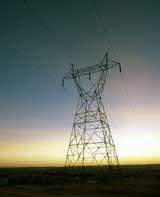DOE’s Preliminary Findings 2012 Congestion Report
The DOE is hosting webinars on its 2012 transmission congestion study:
The study isn’t released out, even a draft, and the powerpoint isn’t available yet online. GRRRRRRRR, we need that to have an idea what’s going on… oh, that’s probably why it isn’t there. Soon, I’ll post it when it appears.
The first webinar was today, just over, and there are two more — just click on linked date to register:
- Thursday, August 16, 2012 2-3:30 pm ET (industry and others)
- Tuesday, August 21, 2012 2-3:30 pm ET (state focus)
What I’m seeing here from the powerpoint is that congestion is a non-issue. And what is very clear from the congestion maps for 2009-2011 is that in 2009 there was essentially NO congestion, and it got worse in 2010, and then not so bad in 2011 but still far more than in 2009. In essence, apparently what they’re doing has made it worse.
They did ask my question, based on the above observation of the 2009, 2010 and 2011 maps, and asked what the explanation was for absence of congestion in 2009:
A: He said that the relatively low level of economic activity was certainly a factor. Temperatures were more severe in 2010 so that was a factor. Yes, congestion, in terms of these three graphics, congestion is worse in 2010 than in the other two years, that is generally in the context of a generally declining pattern over a couple of years we’ve been looking at. Don’t want anyone to get the impression that …. So part of this is that this is a function of scaling also? Yes…
Uh-huh… right…
And then from slide 22, Preliminary Regional Findings: Midwest:
- Data indicate on significant, persistent constraints, apart from those related to the development of remote renewable resources
- Data do not indicate any areas with major reliability problems
- The economic congestion that is occurring is small in relation to the total cost of wholesale electricity traded in organized spot markets.
- Inconsistent market designs and practices between RTOS — as distinct from lack of transmission capacity — are a significant impediment to economically beneficial electricity trade.
But hey, we knew that!
Here are the prior “studies” from DOE:
And remember, the purpose of this is, in THEIR words, from THEIR site:
DOE’s Congestion Studies may contribute information needed to support the future designation of one or more National Interest Electric Transmission Corridors (National Corridors). On the basis of a congestion study, and after reviewing and considering public comments, the Secretary of Energy is authorized but not required to designate related geographic areas as National Corridors. Designation of a National Corridor has two effects: 1) it emphasizes that the Department considers the particular congestion problem to which the corridor pertains to be sufficiently acute to merit federal concern; and 2) it enables the Federal Energy Regulatory Commission to exercise “backstop†authority (under conditions specified in the Federal Power Act) to approve the siting of transmission facilities within the area of the corridor. In particular, the Commission may exercise its jurisdiction if a state agency has “withheld approval†for more than one year of an application to site a transmission facility within the corridor.
But wait, even they admitted in today’s Webinar that the courts have invalidated the designation of National Interest Electric Transmission Corridors both generally and specifically:
So we’re doing this … why???
It’s all about market, it has nothing to do with electric reliability, and billions are being spent to address a problem that does not exist and which is illegal to implement. WRONG? Prove it, please…


Comments
DOE’s Preliminary Findings 2012 Congestion Report — No Comments
HTML tags allowed in your comment: <a href="" title=""> <abbr title=""> <acronym title=""> <b> <blockquote cite=""> <cite> <code> <del datetime=""> <em> <i> <q cite=""> <s> <strike> <strong>